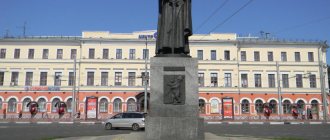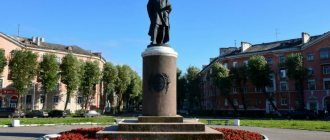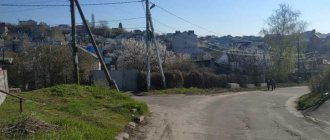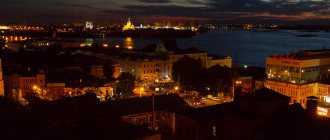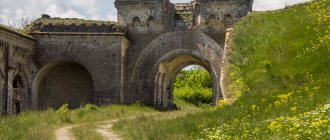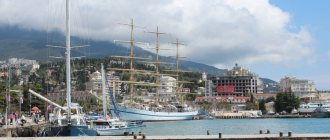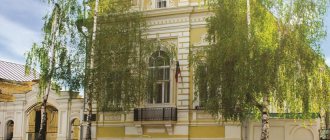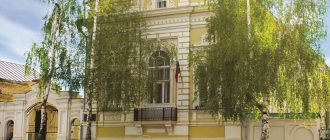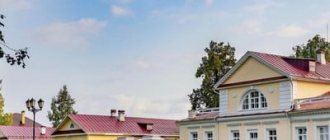The small town of Pitsunda, located on the cape of the same name on the coast of Abkhazia, attracts tourists, first of all, with its unique nature. There are few historical buildings here, but nowhere else will you find such a mixture of sea and mountain air, flavored with the aromas of endemic plants.
There are places to go in the city itself and in its surroundings during your free time from a beach holiday. To make it easier for you to navigate, we have prepared a detailed list of interesting things in and around Pitsunda.
A story about a holiday in Pitsunda: where to eat, live, swim and how not to get poisoned
Pitsunda: what is worth seeing in one day
Pitsunda will be of interest to any category of tourists. The small town of Abkhazia has historical monuments, modern entertainment, and opportunities for passive and active recreation. But first, about its most interesting places that you can visit in a short period of time.
Reserve "Great Pitiunt"
- Coordinates on the map: 43.160335, 40.348327.
The historical and architectural reserve in the very heart of Pitsunda is a piece of the ancient city built by the Greeks and Romans. Pitiunt is the ancient Greek name of the modern town of Pitsunda, translated as “pine”. The settlement received this name due to the dense pine forests that covered the entire cape in ancient times.
The settlement was founded around the 4th century BC. e. The seaside town was a tasty morsel for neighboring states and changed hands several times. Four centuries after its founding, Magna Pitiunt was captured by Roman troops. In the following centuries, the city was part of Abkhazia, Georgia, the Ottoman Empire, the Russian Empire and the USSR.
On the territory of the open-air museum, the remains of ancient stone structures are stored - Roman and Greek houses, military barracks, traditional baths. Here you can see the highest achievement of Roman engineering - the aqueduct. The best preserved ancient Cathedral of St. Andrew the First-Called. The reserve is enclosed by a medieval fortress wall, built in the 16th century.
Central Beach
- Address: Cypress Alley.
Pitsunda is a seaside resort in the Republic of Abkhazia. It is not surprising that most tourists come here to swim and sunbathe. On the central beach of the city you can see dozens of vacationers all year round. The coastline is especially crowded during the swimming season, which lasts almost six months in these latitudes.
The beach is clean and well-maintained, along the shore there are sun loungers, umbrellas for protection from the bright sun and changing cabins.
The entry into the water is quite gentle and suitable for swimming with children. The beach is covered with small pebbles, among which there are occasional sharp pebbles, so tourists are advised to wear special shoes to avoid injuring their feet. For lovers of active recreation and thrills, rental of water equipment is available.
Abkhazian National Dolphinarium
- Address: Naberezhnaya street.
The Pitsunda Dolphinarium opened in 2016 and quickly gained popularity among both local residents and tourists. For children and adults there are performances with the participation of trained dolphins and fur seals. The stands around the pool are covered with a canopy to protect spectators from the scorching sun. Dolphin therapy sessions are available for children with developmental disabilities.
Pine Grove
Pines grew on the territory of Pitsunda a million years ago.
Today, a grove with an area of 200 hectares borders the peninsula on Cape Pitsunda . This is both a nature reserve and a tourist attraction at the same time.
of Pitsunda pine grows here ; the age of some trees reaches 200 years, and all of them have healing properties for human health.
The largest pine tree is called “Patriarch” , its age is about 500 years, its height is 50 meters, and the girth of the tree reaches 7.5 meters.
Each tree has its own number, there are more than 30 thousand in total.
Pine trees contain aromatic substances - phytoncides , which are released when heated in the sun.
These substances are capable of neutralizing pathogenic bacteria, including Koch’s bacillus, the causative agent of tuberculosis.
Not far from the grove there are several former state dachas, where the top party elite of the USSR once rested.
Even during the summer heat there is always a pleasant coolness here. Thousands of trees have been preserving an oasis of healing air with a wonderful pine aroma for centuries.
On the northern side, the grove is adjacent to an array of rare boxwood trees, the phytoncides of which also have a beneficial effect on humans, improve health and prolong life.
Natural attractions in the vicinity of Pitsunda
Like many Abkhaz cities, Pitsunda boasts countless natural resources. In the vicinity of the resort, centuries-old trees grow, rivers and waterfalls rustle, and lakes sleep rhythmically. Some natural sites of Pitsunda are of national importance.
Pitsundo-Myussersky Nature Reserve
- GPS coordinates: 43.177837, 40.461898.
The pine trees growing around the resort are listed in the Red Book of Plants as an endangered species. The need to protect Pitsunda nature arose back in 1885. In Abkhazian forests, centuries-old trees were actively cut down.
In 1910, the state began to protect the reserve, but serious measures to protect nature began to be taken only in 1926. 40 years later, the Pitsunda reserve was merged with the neighboring Myussersky reserve.
In addition to pine trees, chestnuts, oaks, strawberry trees, alder, beeches and hornbeams grow on the reserved land. The youngest trees are 50 years old, the oldest trees are up to 200 years old. The extensive forest is fed by several reservoirs: Lake Inkit and the rivers Ryapsha, Myussera, and Ambra.
Relict pine grove
- Address: Pitsunda Nature Reserve.
About 200 hectares of the Pitsunda Nature Reserve are planted with relict pine trees. The belt of coniferous trees around the city is all that remains of the vast prehistoric forests. Pitsunda pines differ from their sisters from other regions in having unusually long needles.
The ancient grove can be called the lungs of the resort: evergreen trees enrich the surrounding area with oxygen all year round, and the phytoncides released by the resin make the air fragrant and healing.
Abkhazians are sensitive to the precious grove and monitor the safety of each tree. All 30 thousand pines are numbered, the oldest specimens even have their own names. Thus, the oldest pine tree, which recently celebrated its 500th anniversary, is reverently called “Patriarch”. The long-liver reaches 50 m in height and more than 7 m in girth.
Bamboo Grove
- Coordinates: 43.152324, 40.339582.
Another interesting corner of the Pitsunda Nature Reserve. A small plot of land is the only place in Abkhazia where bamboo grows. Some specimens reach the height of a 12-story building. Local authorities monitor the safety of the grove and periodically prohibit visiting it, as careless tourists sometimes break fragile bamboo stems.
Embankment
- Address: Naberezhnaya street.
The central city embankment is one of the most comfortable and crowded places in the resort. The convenient road is paved with paving slabs; every few meters there are benches where you can relax after a long walk. Tall palm trees grow along the embankment. The salty sea air mixes with the aroma of pine trees growing near the shore. In the evenings, street musicians gather here and colorful illuminations are lit.
Lake Inkit
- Coordinates: 43.173763, 40.319238.
Nature itself created this wonderful reservoir 3000 years ago. Initially, the water in the lake was fresh, but gradually mixed with sea water and became slightly salty. The swamp next to the relict lake scared away tourists; in hot weather, the humid air was swarming with malarial mosquitoes.
To get rid of dangerous insects, local residents raised Gambusia fish in Inkita, which feeds on mosquito larvae. On the shore of the lake, a bus stop in the shape of a huge octopus attracts attention. The whimsical design is made of ceramic mosaic.
Bzyb River
The deep Bzyb flows through the whole of Abkhazia. The section of the river near Pitsunda is popular among rafting fans. River descents are very dangerous and, in order to avoid tragedy, tourists are advised to hire an experienced instructor and take all possible safety measures. The river is home to salmon and trout. There is a suspension bridge across the water. Only brave souls dare to cross the shaky road.
Geg waterfall
- Coordinates: 43.435244, 40.441998.
The Gega River flows along the picturesque slopes of the Gagra ridge. At one point, a river flow tunneled through the rock and came out the other side of the rock. Tonnes of icy water erupt from a hole in the wall and crash down the cliff. In 1984, the cave through which the river flows was explored by speleologists from Siberia. The second name of this miracle of nature is Circassian.
Soviet directors loved the Gegsky Falls and repeatedly used it in their films as natural scenery. It was he who “played” the role of the Reichenbach Falls in the famous Soviet film “Sherlock Holmes and Doctor Watson”. On one of the rocky ledges near the cliff, the great London detective and his sworn enemy Professor Moriarty, played by actors Vasily Livanov and Viktor Evgrafov, fought.
First Gorge
- Address: c. Agarki.
A few kilometers from Pitsunda there is a small village of Agarki. The main natural attraction of the settlement is the First Gorge, which is also called “Monastic Gorge”. According to local legend, monks who desired prayerful solitude and ascetic deeds once sought refuge in this remote corner.
Near the gorge there is a convenient beach where families with children and diving enthusiasts like to relax. Crabs live on the reefs in the coastal area. Some active tourists go hiking through the gorge and then swim in the warm waters of the Black Sea. You can quench your thirst in a clean mountain spring.
A few facts about Pitsunda
- Pitsunda is a resort town in Abkhazia, located on Cape Pitsunda, on the Black Sea coast.
- The city belongs to the Gagra district, the distance to the city of Gagra is 20 km.
- The former names of Pitsunda are Pitiunt, Sotirioupolis.
- Pitsunda received city status in 2007.
- The symbol of Pitsunda is a long-leafed relict pine.
- The beaches in Pitsunda are mostly pebble, as throughout Abkhazia.
- The population of Pitsunda is approximately 4.2 thousand people.
- The following films were filmed in Pitsunda: “Scarlet Sails”, “The Beginning”, “Guest from the Future” and others.
- From Pitsunda to the capital of Abkhazia Sukhum - 80 km, to the resorts of Gudauta - 45 km, New Athos - 60 km.
The best Pitsunda museums
Museums in the city of Pitsunda are not numerous, but they are full of valuable exhibits and strange things that will be of interest to people of all generations.
Museum of the History of Pitsunda
- Address: Gitsba street.
The two-story building of the historical museum is located on the territory of the Great Pitiunt complex. In the 19th century, the building belonged to the monastery, and in Soviet times it became the property of the state. Near the entrance, visitors are greeted by intricate wrought iron installations.
Inside, the building is divided into four rooms, which house a small exhibition of archaeological finds. Ancient frescoes, icons, pottery and many other exhibits are kept behind glass display cases.
House-Museum of Khetsuriani
- Address: Ldzaa village, Adamia street.
An unusual museum opened in the village of Ldzaa in the vicinity of Pitsunda. The original building stands out noticeably from the rest of the buildings. The owner of the house and also the founder of the exhibition is the talented entrepreneur Giorgi Khetsuriani. In the 1960s, Georgy Yasonovich was one of the first to figure out how to make money by photographing tourists.
Being a passionate collector, Khetsuriani spent almost all his money on various interesting and valuable items: weapons, cameras, dishes, antique carriages and much more. Georgy Yasonovich built a two-story house with a spiral staircase and a three-tier porch for his meetings.
Each tier is hung with fancy little things. The creative museum is called the “Merchant’s House” or “Hunter’s House” for its richness and diversity. The most valuable exhibit is the original phaeton of the Prince of Oldenburg. After the death of the owner in 1994, the house-museum was inherited by Khetsuriani’s relatives, who opened a small cafe nearby.
Bus stops
Some bus stops in Abkhazia even now look like an unexpected greeting from the future. They are too different from the usual minimalist places to wait for public transport. And in the 1960s, when they were just built according to the designs of Zurab Tsereteli, they generally seemed like futuristic objects.
Bus stop Petushok in Pitsunda
The stops are made of reinforced concrete and decorated with bright cobalt glass mosaics. The shape resembles a giant octopus, fish, wave, rooster... But local residents did not accept such creativity of the architect. The stops were criticized and called inconvenient to use.
Now the stopping pavilions have suffered from the Georgian-Abkhaz war and the wind of times. But even if not restored and dilapidated, they still resemble artifacts of an extraterrestrial civilization scattered among the greenery of Abkhazia.
Architectural heritage of the resort
Pitsunda is an ancient settlement that has survived more than one change of rulers. Every civilization from the Roman Empire to the Soviet Union has left its traces in the form of architectural structures on the Pitsunda land.
Old lighthouse
- Coordinates: 43.147487, 40.342362.
The tall metal lighthouse was built at the end of the 19th century. From 1891 to 1953, workers lit the signal fire using kerosene. In 1953, an electric floodlight appeared on the tower.
Over the many years of operation, the lighthouse has fallen into disrepair and today is not used for its intended purpose. The structure is rusty and threatens to collapse at any moment. To preserve the architectural monument, it was surrounded by metal supports. Entry inside is prohibited; the door has been welded shut for security.
Now the old tower is poorly visible from the sea, since the building is obscured by the taller buildings of the Mayak sanatorium. The name of the sanatorium fully corresponds to its new purpose: signals to sailors are now given from the roof of one of the buildings.
Esher dolmen
- Address: Topolevaya street.
Several thousand years ago, people buried their dead in small tombs - dolmens, made of five stone slabs. Ancient tombs were common on the Black Sea coast. Five dolmens were found on the territory of Abkhazia.
The Pitsunda specimen was brought from the village of Esher in the 70s of the last century and is currently stored on the territory of “Great Pitiunt”. The dolmen was damaged during transportation; the cracks between the slabs had to be filled with concrete.
Dacha K.S. Gamsakhurdia
- Coordinates: 43.167752, 40.333465.
Konstantin Simonovich Gamsakhurdia is a famous Georgian scientist and writer. The writer's country mansion has been preserved in Pitsunda. The house for the classic of Georgian literature was built in the mid-20th century. It is believed that it was in Pitsunda that Konstantin Simonovich wrote his main works. Now the house is abandoned, like many mansions nearby.
Water tower
- Address: Topolevaya street.
On the outskirts of the city, a round brick tower rises on a high hill. The date of construction - 1951 - is indicated directly on the wall; under the numbers there is a five-pointed star, one of the symbols of the Soviet Union. The building has long been abandoned, the roof has collapsed, but the walls are in good condition.
Bus stops
Public transport stops in Pitsunda are a separate form of art. In the 60s, creative people often departed from the canons of Soviet architecture and took a creative approach to doing their work. Many futuristic objects are the creations of the famous sculptor Zurab Tsereteli.
Among the most striking stops are giant structures in the shape of a rooster, octopus, and sea waves. Some shelters were damaged during the Georgian-Abkhaz War. Unusual buildings irritate many local residents, but invariably attract the attention of tourists.
Sculpture "Medea"
According to archaeological research, the legendary Colchis from ancient Greek myths was located somewhere in Abkhazia. Perhaps Pitsunda was the birthplace of the Colchian princess Medea, a beautiful and fierce sorceress. For the sake of her beloved Jason, who arrived on the shores of Colchis on the ship "Argo", she betrayed her father, killed her brother and committed many more crimes. But Jason left Medea to marry another and become the rightful king. Abandoned Medea took terrible revenge: she poisoned her bride and killed her children from Jason.
In the south of Cape Pitsunda, almost at the very edge of the coast, there is a 5-meter bronze sculpture “Medea”, created by national artist Merab Berdzenishvili. The Colchis princess-witch is depicted at a fateful moment: she is now deciding to take cruel revenge. She is huge and black, like her love and hatred for Jason. She still holds her children close to her with impossibly large hands, but will soon take the sword tied to her hip.
Beautiful Pitsunda temples and churches
The few churches in Pitsunda belong to Christians. Only two temples have been preserved in good condition; the rest of the buildings are in ruins.
Cathedral of St. Andrew the First-Called
- Address: Gitsba street, 8.
The ancient temple of Pitsunda is the main attraction of the Great Pitiunt nature reserve. The first cathedral was built back in the 4th century at the height of the persecution of Christians. Since then, the building has undergone many changes. In the 10th century, the building came into the possession of the Catholic Church. The structure was completely rebuilt, new walls were made of red brick and strong limestone blocks.
The period of Ottoman rule became a difficult ordeal for many Abkhazians. Pitsunda Christians fled from Muslim persecution; the ancient cathedral remained abandoned for many years. In the 19th century, the patriarchal cathedral was restored and re-consecrated in honor of the Dormition of the Blessed Virgin Mary.
Fragments of ancient paintings have been preserved under the dome and on the walls; in the western part of the church there are the tombs of the apostles Andrew the First-Called and Simon the Zealot. In 1975, a 10-meter German-made organ appeared in the temple. Now the cathedral hosts organ music concerts.
Chapel of the Pitsunda Saints
- Address: Platanovaya street.
The small stone chapel is one of the treasures of the Great Pitiunt Nature Reserve. Looking at the rough stonework, you might think that the small church is the same age as the Patriarchal Cathedral. However, the chapel is much younger than its ancient neighbor: the unique landmark was erected in 1991.
The construction was carried out by the brethren of the New Athos Monastery; the monks built the walls from stones left over from the first chapel, created back in the 5th century. The ruins of an ancient structure stand a few meters from the new building. The chapel is the only functioning temple in Pitsunda; services are performed by visiting priests. There is a church shop inside.
Cave of New Athos
The New Athos cave, located under the Iveron Mountain, is one of the largest caves in the world. The cave cavity occupies about 1 million square meters.
The structure of the cave is a labyrinth consisting of halls and passages around its perimeter. The cave cavity is filled with stalactites and minerals. In some rooms you can see cave lakes.
- Because this attraction is popular. There is a possibility that you will have to wait in line
- The temperature in the cave is about +11 degrees Celsius
- The entrance ticket costs 400 rubles.
- To take photographs you will need to purchase a permit for 50 rubles. The fine for filming on location without permission is 1000 rubles.
- The general tourist route through the cave is 2 km, and the excursion itself lasts 1.5 hours.
“You can get to New Athos by bus from the central square of Pitsunda in 30-40 minutes.”
Monuments and sculptures in Pitsunda
Pitsunda monuments are distinguished by a variety of forms and themes. Here you can see mournful monuments dedicated to tragic events and famous fellow countrymen, as well as figures of mythical characters and simply beautiful statues created solely to decorate the city.
Pearl divers
- Address: st. Embankment.
A thematic sculptural composition decorates the city embankment. A naked girl and a young man dive in white arches-waves, trying to get a pearl shell from the bottom. Fish swim near the young people and dolphins frolic.
A fountain plays under the sculptures. The author of the wonderful composition is the Georgian master Irakli Ochiauri. During Soviet times, the object was almost banned due to censorship: Soviet moral guardians did not like the fact that the young couple was not wearing swimsuits.
Medea
- Address: Pitsunda beach.
The daughter of the king of Colchis, the sorceress Medea from ancient myth, is a symbol of crazy, passionate love, capable of committing terrible acts out of jealousy. Medea dedicated her life to the hero Jason, went through terrible trials with him, sometimes saving her beloved with the help of black magic. However, the hero decided to marry the young daughter of another king. The priestess, distraught with grief, decided to take revenge on the traitor.
Medea pretended that she had come to terms with her lover’s departure and ordered him to give his rival a tunic as a sign of reconciliation. After Jason left, the sorceress killed their common children and committed suicide. The donated clothes were sent and the bride died instantly. The would-be groom returned to his mistress and discovered three lifeless bodies.
Bronze Medea appeared in Pitsunda in 1969. The three-meter sculpture instantly attracts the attention of tourists who come to the central beach. Long robes flutter like black smoke over the head of an angry priestess. Small children swarm carefree at the woman’s feet, whom she will kill in a moment with the sword hanging on her hip.
Monument to those killed in wars
- Address: st. Gitsba.
In one of the districts of Pitsunda, a small park has been laid out in memory of local residents killed during the Great Patriotic and Georgian-Abkhaz wars. In the center there is a white granite arch - a monument to the dead. Under the stone arches lies a slab, on one side the names of the victims of the Great Patriotic War are engraved, on the other - those who fell in the early 90s.
Monument in the village Ldzaa
- Address: pos. Ldzaa.
In the village of Ldzaa, not far from Pitsunda, another monument was erected in memory of the military conflict between Georgia and Abkhazia. A map of Abkhazia is depicted on seven white slabs; in the upper right corner a golden ball shines, from which shiny threads emanate, like rays from the sun. Golden rays indicate settlements with the greatest number of victims. At the pedestal there are black plaques with the names of the dead. Every year, mourning wreaths are laid at the foot of the monument.
Monument to A.S. Agrbe
- Address: Gochua street.
Alexey Sergeevich Agrba is a prominent Soviet politician, a native of the village of Ldzaa. Having received his education, the young man taught at his native school, but became famous for his achievements in a field far from pedagogy. After the events of 1917, Alexey Sergeevich joined the underground Revolutionary movement. In 1920, the young man was arrested for his activities, but was soon released, as Soviet power was established in Abkhazia.
For his loyalty to Bolshevik ideas, Agrba was appointed chairman of the Kodori Revolutionary Committee. From that moment on, the former teacher’s rapid career growth began. During his 16 years of service, Alexey Sergeevich changed several political structures in Abkhazia, Georgia and Azerbaijan and received many awards: two “Honorary State Security Officer” badges, two “Red Banner of Labor” orders, and the Order of Lenin.
In 1937, a criminal case was fabricated against Agrba on charges of counter-revolutionary activities. In the spring of 1938, the politician was shot, and a few years later he was posthumously rehabilitated. In Pitsunda, near one of the schools, a bronze bust was erected in honor of the famous fellow countryman.
Stone girl
- Address: Pitsunda embankment.
A wonderful statue on the Pitsunda coast is the creation of Zurab Tsereteli. A naked girl with flowing hair sits under the pine trees, her beautiful face is thoughtful and sad. She supported her head with one hand and placed the other on her knees. The sad beauty is considered one of the best sculptures of Pitsunda.
Don't miss the sights of other cities of Abkhazia - Gudauta, Sukhum and Gagra
Pitsunda is a wonderful child of nature, who was raised by three civilizations that once ruled Abkhazia. The city attracts with its warm sea and Abkhazian flavor, and enchanting landscapes and historical mysteries promise an amazing journey full of adventures and new discoveries.
Sculptural composition “Divers”
The embankment of Pitsunda Street, 5 km long, is completed by the sculpture “Pearl Divers”. Three-meter arches imitate waves on which the figures of a young man and a girl seem to hang, surrounded by dolphins and fish. Young people reach out to the shell where the pearl should be, and a fountain gushes out of it.
The art object created by the Georgian sculptor Irakli Ochiauri has long become a symbol of an eternally young summer and carefree holiday. But at the time, the sculpture was not opened right away, because according to officials, Soviet boys and girls do not swim naked, like the “Divers.”

